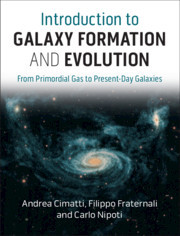Description
Introduction to Galaxy Formation and Evolution
From Primordial Gas to Present-Day Galaxies
Authors: Cimatti Andrea, Fraternali Filippo, Nipoti Carlo
A comprehensive examination of nearly fourteen billion years of galaxy formation and evolution, from primordial gas to present-day galaxies.
Language: English
Subject for Introduction to Galaxy Formation and Evolution:
76.41 €
In Print (Delivery period: 14 days).
Add to cart
Publication date: 10-2019
582 p. · 19.2x25.2 cm · Hardback
582 p. · 19.2x25.2 cm · Hardback
Description
/li>Contents
/li>Biography
/li>
Present-day elliptical, spiral and irregular galaxies are large systems made of stars, gas and dark matter. Their properties result from a variety of physical processes that have occurred during the nearly fourteen billion years since the Big Bang. This comprehensive textbook, which bridges the gap between introductory and specialized texts, explains the key physical processes of galaxy formation, from the cosmological recombination of primordial gas to the evolution of the different galaxies that we observe in the Universe today. In a logical sequence, the book introduces cosmology, illustrates the properties of galaxies in the present-day Universe, then explains the physical processes behind galaxy formation in the cosmological context, taking into account the most recent developments in this field. The text ends on how to find distant galaxies with multi-wavelength observations, and how to extract the physical and evolutionary properties based on imaging and spectroscopic data.
Preface; 1. Introduction; 2. The cosmological framework; 3. Present-day galaxies as a benchmark for evolutionary studies; 4. Present-day star-forming galaxies; 5. Present-day early-type galaxies; 6. The environment of present-day galaxies; 7. Formation, evolution and properties of dark matter halos; 8. Main ingredients of galaxy formation theory; 9. From recombination to reionisation; 10. Theory of galaxy formation; 11. Observing galaxy evolution; Appendix A. Acronyms; Appendix B. Constants and units; Appendix C. Astronomical compendium; Appendix D. Physics compendium; References; Index.
Andrea Cimatti is full Professor of Astrophysics at the Università di Bologna. He has worked in Germany, the USA, and Italy at the INAF Arcetri Astrophysical Observatory. His research uses the largest telescopes in space and on Earth to study galaxies and cosmology. He is one of the founders of ESA's Euclid space mission. He is a recipient of the Bessel Prize of the Alexander von Humboldt Foundation, among others. He teaches courses on fundamental astronomy and on galaxy formation and evolution. He has published key papers based on observational studies of distant galaxies.
Filippo Fraternali is Associate Professor of Gas Dynamics and Evolution of Galaxies at the Kapteyn Astronomical Institute of the Rijksuniversiteit Groningen, The Netherlands. He obtained his Ph.D. from the Università di Bologna, where he was an assistant professor between 2006 and 2017. He did postdoctoral research in the Netherlands and was a Marie-Curie fellow at the University of Oxford. He has published extensively on various topics of galaxy formation and evolution.
Carlo Nipoti is Associate Professor of Astrophysics at the Università di Bologna, where he received his Ph.D. in Astronomy, and he was a temporary lecturer of Theoretical Physics at the University of Oxford. He teaches courses on the physics of galaxies and on the dynamics of astrophysical systems at undergraduate and graduate levels. His research is in the field of theoretical astrophysics with special interest in the formation, evolution and dynamics of galaxies, on which he is author of valuable papers.
Filippo Fraternali is Associate Professor of Gas Dynamics and Evolution of Galaxies at the Kapteyn Astronomical Institute of the Rijksuniversiteit Groningen, The Netherlands. He obtained his Ph.D. from the Università di Bologna, where he was an assistant professor between 2006 and 2017. He did postdoctoral research in the Netherlands and was a Marie-Curie fellow at the University of Oxford. He has published extensively on various topics of galaxy formation and evolution.
Carlo Nipoti is Associate Professor of Astrophysics at the Università di Bologna, where he received his Ph.D. in Astronomy, and he was a temporary lecturer of Theoretical Physics at the University of Oxford. He teaches courses on the physics of galaxies and on the dynamics of astrophysical systems at undergraduate and graduate levels. His research is in the field of theoretical astrophysics with special interest in the formation, evolution and dynamics of galaxies, on which he is author of valuable papers.
© 2024 LAVOISIER S.A.S.
These books may interest you

Secular Evolution of Galaxies 83.44 €



